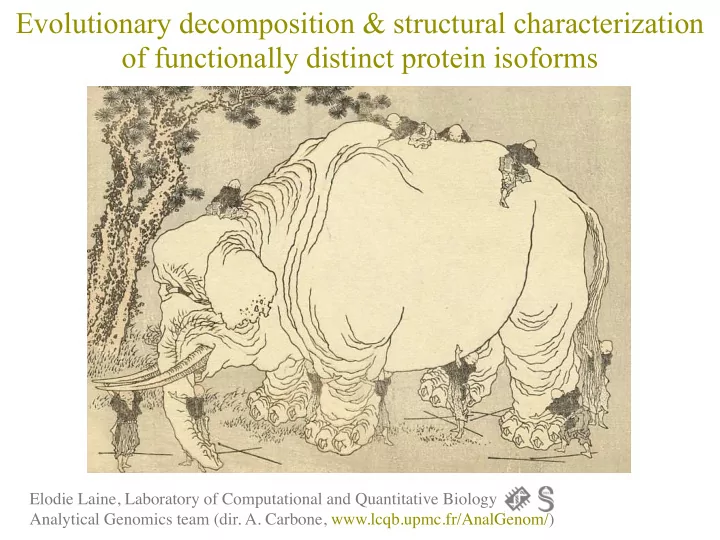

Evolutionary decomposition & structural characterization of functionally distinct protein isoforms Elodie Laine, Laboratory of Computational and Quantitative Biology Analytical Genomics team (dir. A. Carbone, www.lcqb.upmc.fr/AnalGenom/)
Alternative Splicing Gene 2
Alternative Splicing Gene 2
Alternative Splicing Gene Transcription mRNA transcripts 2
Alternative Splicing Gene Transcription mRNA transcripts Translation Protein isoforms 2
Traveling in India 3
Traveling in India Alternative starts 3
Traveling in India Mutually Alternative exclusive starts 3
Traveling in India Insertion Mutually Alternative exclusive starts 3
Traveling in India With many lines, the network may become quite complex! 4
Main questions ● How does alternative splicing impact protein structure and interactions? ● What are the evolutionary ages of observed alternative splicing events? ● How did alternative splicing induced new functions in evolution? 5
Methodology ThorAxe To find orthologous exons PhyloSofS To reconstruct transcripts’ phylogenies and predict isoforms’ 3D structures 6
Inputs & Outputs Annotated transcripts 7
Inputs & Outputs Splice graph Annotated transcripts s-exon 3D model Phylogenetic forest 7
S-exon identification 8
Molecular modelling Structural template search is 0 1 0 1 2 0 2 4 2 4 4 performed in an iterative way 1 1 3 4 2 0 4 4 0 3 and centered on s-exons . First iteration Predict Search for Evaluate structural structural coverage features templates #(templates) Annotate s-exons s-exon Generate 3D models 9
Molecular modelling Structural template search is 0 1 0 1 2 0 2 4 2 4 4 performed in an iterative way 1 1 3 4 2 0 4 4 0 3 and centered on s-exons . After 4 iterations Predict Search for Evaluate structural structural coverage features templates #(templates) Annotate s-exons s-exon Generate 3D models 9
Case study - CAMK2B 10
Case study - CAMK2B 10
Case study - CAMK2B Proline-rich regions, likely to be involved in interactions 10
Case study - MYO1B 11
Case study - MYO1B CAM-binding motifs s-exons Template 4R8G 11
A few more examples JNK family Number of templates by exons 95 90 0- 24.99% 85 25- 49.99% 80 50- 74.99% NEBL 75 75- 100% Number of templates 70 65 60 55 50 45 40 35 30 25 20 15 1_5 16_0 9_5 10 3_4 8_3 20_0 19_0 5_0 5 9_1 9_2 3_3 8_1 8_0 5_7 15_0 0 % Q ) + 0 1 2 3 6 R 5 S 9 : T < = ? A 7 C D E F U V H I J K L M N O P 9_6 1_0 8_2 9_7 9_8 9_9 9_10 9_11 9_12 Exons 5_4 11_0 1_1 1_2 1_3 9_3 1_4 9_14 9_4 9_13 5_3 1_6 5_1 3_0 17_0 5_2 21_0 7_0 70 1_8 5_6 13_0 4_0 start 65 0- 24.99% 75- 100% 5_5 1_7 60 12_0 2_1 2_0 2_2 stop 55 3_5 50 3_2 0_1 14_0 18_0 Number of templates 45 9_0 3_1 40 0_2 35 30 6_0 25 20 15 10 5 0 W X Y Z J M N O P Exons 12
Summary of the results 50 human genes… ๏ belonging to 16 families ๏ across 12 species ๏ ~900 transcripts (Ensembl) ๏ [8-91] s-exons (ThorAxe) 13
Summary of the results 50 human genes… 69 conserved AS events ๏ belonging to 16 families involving 105 s-exons ๏ across 12 species ๏ ~900 transcripts (Ensembl) ๏ [8-91] s-exons (ThorAxe) Alter End Not documented Insertion/ Alter Start Described Deletion in the Exclusive literature tuple With structural Not information characterized 13
Summary of the results 50 human genes… 69 conserved AS events ๏ belonging to 16 families involving 105 s-exons ๏ across 12 species ๏ ~900 transcripts (Ensembl) ๏ [8-91] s-exons (ThorAxe) Alter End Not documented Insertion/ Alter Start Described Deletion in the Exclusive literature tuple 9 binding affinity (prot) binding affinity (RNA) binding specificity (DNA) cellular localization immunological recognition partner dissociation With partner specificity structural regulation Not unknown information characterized 13
Protein interactions PAX6 FYN substrate DNA sequence binding specificity FMR1 TPM1 partner RNA binding dissociation affinity 14
Perspectives ๏ Transfer protein interaction annotations ๏ Characterize disordered regions ๏ Compare conformational preferences ๏ Include RNA-seq data to better estimate conservation levels ๏ Automatically detect events of interest in the splice graph 15
ThorAxe & PhyloSofS https://github.com/PhyloSofS-Team Analytical Genomics @LCQB Hugues Richard Robert Koch Institut Diego Javier Zea THANKS! Antoine Labeeuw Sofya Laskina Alexander Korzec Adel Ait-Hamlat Lélia Polit
Recommend
More recommend